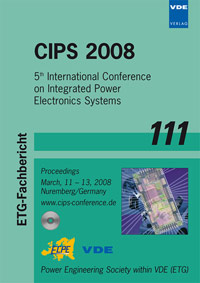Direct Substrate Cooling of Power Electronics
Conference: CIPS 2008 - 5th International Conference on Integrated Power Electronics Systems
03/11/2008 - 03/13/2008 at Nuremberg, Germany
Proceedings: CIPS 2008
Pages: 5Language: englishTyp: PDF
Personal VDE Members are entitled to a 10% discount on this title
Authors:
Skuriat, Robert; Johnson, C. M. (The University of Nottingham, United Kingdom)
Abstract:
Thermal management technologies for power electronic systems are currently recognised as a key limiting factor in meeting the weight, volume and reliability objectives for a range of high performance applications, including aerospace, automotive and rail traction. The heat transfer path in a power module consists of many layers of different materials. This structure is susceptible to thermal cycling, as each layer expands differently with temperature due to the varying coefficients of thermal expansion. A particular area of concern is the solder bonded interface between the substrate tiles and heat spreader (baseplate). In addition, such heat spreaders are typically optimised for mounting on large heat sinks with relatively low effective heat transfer coefficients to the cooling fluid. In this paper a direct water cooling technique is presented where the effective heat transfer coefficient is so high (typically 20 kW/(m2K)) that a heatspreader is not needed. By removing the baseplate the thermal resistance, mass and volume of the combined electronic package and cooler is reduced. At the same time potential improvements to reliability are realised through the removal of the bonded interface between the substrate and baseplate and the interface between the heat spreader and heat sink.


